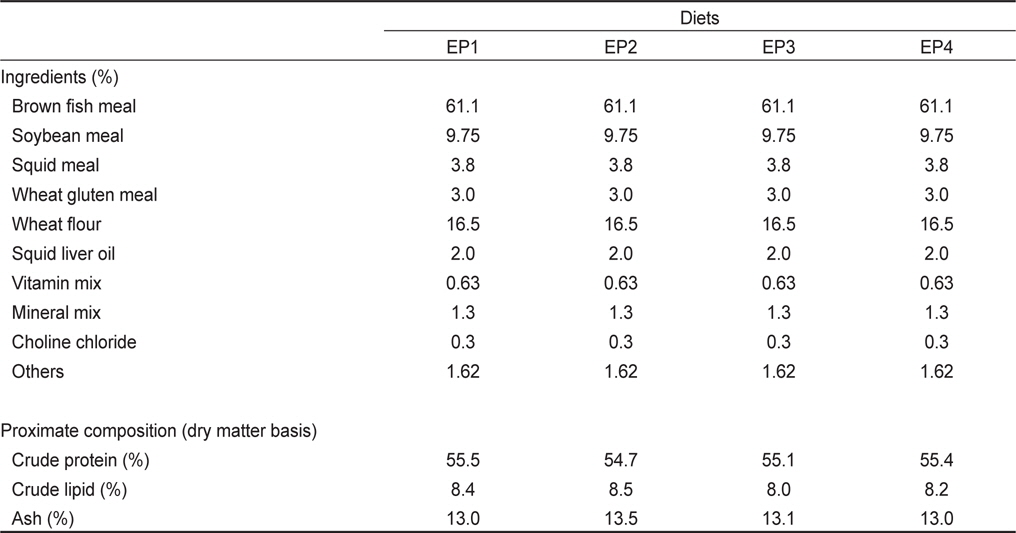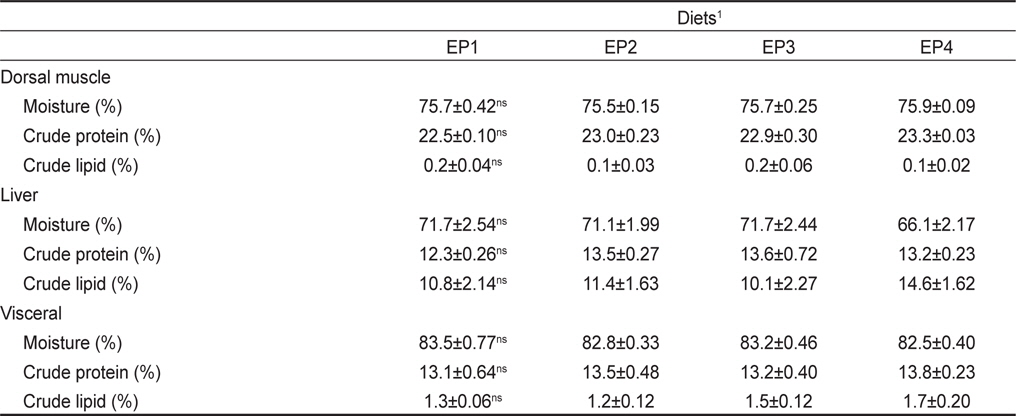



The aim of this study was to investigate the effect of diet extruder conditions, such as feed-loading rate and screw speed, on growth performance and biochemical responses in olive flounder
어류양식에 있어 사료는 어류의 성장과 체내대사에 영향을 미치는 주요한 요인이며, 사료비는 어류양식 생산단가의 많은 부분을 차지하므로 효율적인 양식장 운영을 위해서는 양식 대상종의 사육에 적합한 경제적인 고품질 배합사료의 개발이 필수적이다. 넙치는 우리나라에서 가장 많은 량이 양식으로 생산되고 있는 주요 해산 양식어종이며, 넙치 양식에 적합한 배합사료를 개발하기 위하여 영양소 요구량(Lee et al., 2000; Kim et al., 2002; Lee and Kim, 2005), 사료원료 이용성(Lee et al., 2008) 및 실용배합사료 효능 평가(Kim et al., 2006; 2008)에 관한 연구들이 활발히 수행되어져 왔다.
사료는 양식 대상종의 생존 및 성장에 요구되는 영양소를 고루 함유하여야 하며, 운송 및 취급 시 형상이 변형되거나 파손되지 않도록 충분한 강도를 유지하여야 한다. 또한 양식사료는 물속에 공급된 후 양식어에게 섭취되므로 대상종이 섭취하기에 용이한 물성을 유지하여야 한다. 사료의 물성이나 가공 형태는 제조공정, 사료단가, 유통 및 수질 오염 등에 영향을 미치는 주요한 요인이며, 어종 마다 선호하는 사료의 형태나 물성이 다를 수 있다(Lee and Jeon, 1996). 따라서 대상종의 양식에 가장 적합한 형태의 사료를 제조하여 사용하는 것은 양식 생산성 향상을 위해서 중요하다.
최근 어류 양식용 배합사료(extruded pellet; EP)는 대부분 익스트루더를 사용하여 압출성형 공정에 의해 제조된 형태로 생산되고 있다. EP의 품질은 익스트루더(extruder)를 사용한 사료 공정 중 원료 공급량, 수분 함량, 스크류 회전속도 및 바렐의 온도와 같은 조건에 영향을 받을 수 있다(Serge et al., 2011). 그러나 익스트루더의 가공조건에 따른 EP의 물리적 특성변화에 관한 연구는 일부 보고되었지만(Chevanan et al., 2008; Lee, 2011), 익스트루더의 가공 조건을 다르게 하여 제조한 EP 공급에 따른 넙치 사육효능 평가에 관한 연구는 미비한 실정이다. 그래서 본 연구에서는 동일한 사료조성으로 익스트루더의 원료공급량 및 스크류 회전속도를 다르게 하여 제조한 EP의 공급이 넙치의 성장 및 체조성에 미치는 영향을 조사하였다.
실험사료의 원료조성과 영양성분 분석 결과를 Table 1에 나타내었다. 실험사료의 원료로는 시판 상품사료에 주로 사용되는 원료들로 선정하였으며, 주요 단백질원으로 갈색어분과 대두박을 사용하였고, 지질원으로는 오징어간유를 사용하였으며, 탄수화물원으로는 소맥분을 사용하였다. 모든 실험사료의 원료조성은 동일하게 설계하였으며, 익스트루더(twin-screw extruder, ATX-Ⅱ, Fesco, Korea)의 가공조건에 따른 EP의 넙치사육효과를 조사하기 위하여 사료원료 공급속도(kg/h)와 바렐의 스크류 회전속도(rpm/min) 조절을 통해 총 4종류의 실험사료를 제조하였다(사료원료 공급속도/스크류 회전속도; 50/640, 80/640, 120/640, 80/400) (Table 2).
[Table 1.] Ingredients and nutrient compositions of the experimental diet

Ingredients and nutrient compositions of the experimental diet
[Table 2.] Extruder operating conditions and floating time of experimental diet

Extruder operating conditions and floating time of experimental diet
실험어는 최초 평균체중 149±0.6 g 의 넙치를 총 12개의 2톤 원형수조에 각 수조별로 50마리씩 수용하여, 사료별 3반복으로 무작위 배치하였다. 실험사료는 1일 2회(09:00, 17:00) 만복 공급하였으며, 8 주간 사육실험을 실시하였다. 사육기간 동안 평균 수온은 18.5 (±1.1)℃였으며, 사육수는 각 수조에 20 L 내외로 조절하여 흘려주었다.
어체 측정은 사육실험 시작시와 종료시에 측정 전일 절식시킨 후, 각 수조에 수용된 모든 실험어의 전체무게를 측정하였다. 어체 성분분석을 위하여 실험 종료시 각 실험수조에서 10마리의 실험어를 시료로 취하여 냉동(-75℃)보관하였다. 실험사료와 실험어의 조단백질(N×6.25)은 Auto Kjeldahl system (Gerhardt VAP50OT/TT125, Germany)을 사용하여 분석하였다. 조지질은 조지질추출기(Velp SER148, Italy)를 사용하여 ether로 추출한 후, 측정하였으며, 수분은 135℃에서 2시간 동안 건조 후 측정하였고, 조회분은 600℃ 회화로에서 4시간 동안 태운 후 측정하였다.
결과의 통계처리는 SPSS 프로그램을 사용하여 One-way ANOVA-test를 실시한 후 Duncan’s multiple range test (Duncan, 1995)로 평균간의 유의성을 검정하였다.
익스트루더의 원료 공급량 및 스크류 회전속도를 다르게 하여 EP를 제조한 결과, 스크류의 회전속도는 실험사료의 부상도에 영향을 미쳤다(Table 2). 스크류 회전속도 640 rpm/h으로 제조된 EP1, EP2 및 EP3은 해수에서 24시간 이상 부상되었으나, 스크류 회전속도 400 rpm/h으로 제조된 EP4는 해수에서 10초에서 5분 정도 부상된 후, 서서히 가라앉았다. 그러나 스크류 회전속도 400 rpm/h 이하로 제조된 사료는 해수에서 부상되지 못하고 가라앉았다. 이와 같이 익스트루더를 사용한 배합사료 제조시 스크류 회전속도의 증가는 EP의 부상도를 높였으며, 이는 스크류 회전속도가 증가할수록 사료의 밀도가 낮아지기 때문인 것으로 판단된다. 익스트루더의 스크류 회전속도 증가에 따른 성형물의 밀도 저하는 Lee (2011)의 연구에서도 보고되었으며, 원료혼합물에 소맥분을 첨가할 경우 성형물의 밀도 감소 변화가 더 크게 나타났다.
익스트루더의 가공조건을 다르게 하여 제조한 실험EP로 넙치를 사육한 결과를 Table 3에 나타내었다. 실험어의 최종체중 및 증체량은 원료공급량 및 스크류 회전속도가 낮은 EP1 및 EP4 실험구가 원료공급량 및 스크류 회전속도가 상대적으로 높은 EP2 및 EP3 실험구에 비하여 유의하게 높았다(

Growth performance and feed efficiency of flounder fed experimental extruded pellets (EP1, EP2, EP3 and EP4) with different feed rate and screw speed for 8 weeks
압출성형공정은 혼합, 분쇄, 가열, 성형 및 건조와 같은 단위조작이 단시간에 일어나는 단일공정으로 단시간 동안의 고온, 고압처리 및 스크류의 고속회전에 의해 발생한 강한 전단력을 이용하여 기능성 및 관능적 특성이 우수한 제품을 생산할 수 있다(Harper, 1981; 1989). 최근 어류 양식용으로 사용되고 있는 배합사료는 대부분 익스트루더를 사용하여 제조된 EP 형태로 제조되고 있다. 일반적으로 익스트루더를 사용한 사료 제조시 원료공급 속도, 수분함량, 스크류 회전속도, 사출기의 구조, 바렐온도 및 사료원료 조성비는 EP의 특성에 영향을 미친다(Serge et al., 2011). 본 연구에서 익스트루더의 스크류 회전 속도는 성형된 EP의 부상도와 넙치의 성장에 영향을 미쳤으며, 스크류 회전속도를 높게하여 제조한 EP 실험구에서 낮은 성장을 보였다. 익스트루더의 스크류 회전속도 변화에 따른 EP의 물리적 특성변화를 조사한 Chevanan et al. (2008)의 연구에서 스크류의 회전속도 증가는 성형된 EP의 내구성(pellet durability)을 증가시키는 것으로 보고되었다. 어류는 섭취한 사료가 연질(soft)일수록 소화하기에 용이할 것이며, 스크류 회전속도 증가로 경도가 증가한 EP의 섭취는 어류 체내에서의 소화 및 사료 이용율을 저하시킬 수 있을 것으로 판단된다. 양식용 사료는 수중에서의 부상 정도에 따라서 물위에 떠있는 부상사료와 물속에서 가라앉는 침강사료로 구분할 수 있으며, 대상종의 사료섭취 생리와 양식시설 등의 특성을 감안하여 대상종의 사료섭취에 적합한 형태의 사료로 제조되어야 한다. 국내에서의 넙치 양식은 대부분 육상 수조식 양식장에서 부상형태의 사료를 사용하여 이루어지고 있다. 따라서 넙치 사육용 EP 제조시 수조 내에서 넙치의 사료 섭취가 용이한 부상도를 유지하며, 운송 및 취급에 적합한 정도의 강도의 범위 내에서는 스크류 회전속도를 낮추는 것이 넙치 사육용 EP의 품질 향상을 위하여 효율적일 것으로 판단된다.
본 연구에서 익스트루더를 사용한 EP 제조시 원료공급량도 넙치의 성장 및 사료효율에 영향을 미쳤으며, 동일한 스크류 회전 속도에서는 원료 공급량을 높여 제조한 EP 실험구의 성장 및 사료효율이 저하되는 결과를 보였다. 사료원료 공급량의 변화는 익스트루더의 예비가열 수분조절기(conditioner)에 사료원료가 머무르는 시간에 영향을 미친다. 사료원료 공급량을 적게할 경우, 예비가열 수분조절기내의 원료에 스팀 및 열이 가해지는 시간이 증가하여 제조된 EP의 영양소 이용성에 영향을 미칠 수 있을 것으로 판단된다. Barrows et al. (2007)의 연구에서도 원료 공급속도를 다르게 하여 제조한 EP로 무지개송어를 사육한 결과, 성장도 및 사료섭취율에 유의한 차이를 보였다. 그러나 본 연구에서 실험어의 일일사료섭취율은 원료공급량 및 스크류 회전속도에 영향을 받지 않았다. 이러한 사료섭취율의 차이는 어종, 실험사료의 원료조성 및 사료가공 조건의 차이에 의한 것으로 판단된다.
사육실험 종료시, 실험어 등근육, 간 및 내장의 일반성분은 모든 실험구에서 유의한 차이를 보이지 않아 원료공급량 및 스크류 회전속도를 다르게 제조한 EP의 영향을 받지 않았다(Table 4).

Proximate composition of flounder fed experimental extruded pellets (EP1, EP2, EP3 and EP4) with different feed rate and screw speed for 8 weeks
본 연구에서 원료공급량 및 스크류 회전속도를 다르게 제조한 EP의 공급은 넙치의 성장 및 사료효율에 영향을 미쳤으며, EP 제조시 원료공급량을 감소시키고 스크류 회전속도를 느리게 할수록 넙치의 성장 및 사료효율이 개선되는 결과를 보였다. 이러한 결과로 볼 때, EP 제조를 위한 익스트루더의 적정제조 조건 설정은 배합사료의 품질 향상에 기여할 수 있을 것으로 판단된다.



